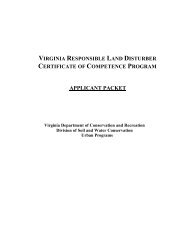Rare Animals - Virginia Department of Conservation and Recreation ...
Rare Animals - Virginia Department of Conservation and Recreation ...
Rare Animals - Virginia Department of Conservation and Recreation ...
You also want an ePaper? Increase the reach of your titles
YUMPU automatically turns print PDFs into web optimized ePapers that Google loves.
LIST FORMAT<br />
The <strong>Rare</strong> Animal List is sorted by broad taxonomic groups <strong>and</strong> then ordered alphabetically by scientific name within<br />
each group. The list format consists <strong>of</strong> six fields: scientific name, common name, global rank, state rank, federal status,<br />
<strong>and</strong> state status. These fields are also used in the lists appearing in Appendices 1-5. To aid in the interpretation <strong>of</strong> the<br />
lists, a brief explanation <strong>of</strong> each field <strong>and</strong> a summary <strong>of</strong> abbreviations follow.<br />
Column 1. Scientific name:<br />
Nomenclature <strong>of</strong> animals is not contained in any single source. The most recent taxonomic sources are examined by the<br />
staff zoologist <strong>and</strong>, when necessary, direct consultations with experts are used to maintain the most scientifically accepted<br />
names for all animal groups. Divergences from these opinions are rare <strong>and</strong> generally occur only while an ongoing<br />
taxonomic study is being conducted. Contact the staff zoologist if you have questions or comments regarding the<br />
scientific names used herein.<br />
Column 2. Common name:<br />
A common name is provided for the convenience <strong>of</strong> the user. St<strong>and</strong>ard common names have been developed <strong>and</strong><br />
universally adopted for only a few animal groups; therefore, the user is cautioned to use scientific names whenever<br />
possible. The common names for most vertebrates <strong>and</strong> a few selected aquatic invertebrate groups (e.g., mussels) are<br />
recognized as stable. Most invertebrate species lack common names <strong>and</strong> it may not be practical to provide such names.<br />
They are usually indicated in the list as “a caddisfly”, “a millipede”, etc. The primary sources <strong>of</strong> common names applied<br />
to species in selected groups included in this list can be found on page 6. Many other common names that appear in the<br />
list, especially those <strong>of</strong> invertebrates, are not widely used or universally accepted.<br />
Column 3. Global rank:<br />
Global ranks are assigned by a consensus <strong>of</strong> the network <strong>of</strong> natural heritage programs, scientific experts, <strong>and</strong> NatureServe<br />
(a non-pr<strong>of</strong>it conservation organization) to designate the rangewide rarity <strong>of</strong> a species or subspecies. This system was<br />
originally developed by The Nature Conservancy <strong>and</strong> is widely used by other agencies (e.g., U.S. Fish <strong>and</strong> Wildlife<br />
Service, U.S. Forest Service) <strong>and</strong> organizations as the best available scientific <strong>and</strong> objective assessment <strong>of</strong> an animal’s<br />
rarity <strong>and</strong> the level <strong>of</strong> threat to its existence. The ranks are assigned after considering a suite <strong>of</strong> factors including the<br />
number <strong>of</strong> occurrences (populations), number <strong>of</strong> individuals, <strong>and</strong> severity <strong>of</strong> threats to the species <strong>and</strong> its habitats. Global<br />
ranks found in the <strong>Rare</strong> Animal List are explained below:<br />
G1 Extremely rare <strong>and</strong> critically imperiled with 5 or fewer occurrences or very few remaining individuals;<br />
or because <strong>of</strong> some factor(s) making it especially vulnerable to extinction.<br />
G2 Very rare <strong>and</strong> imperiled with 6 to 20 occurrences or few remaining individuals; or because <strong>of</strong> some factor(s)<br />
making it vulnerable to extinction.<br />
G3 Either very rare <strong>and</strong> local throughout its range or found locally (even abundantly at some <strong>of</strong> its locations) in<br />
a restricted range; or vulnerable to extinction because <strong>of</strong> other factors. Usually fewer than 100 occurrences<br />
are documented.<br />
G4 Common <strong>and</strong> apparently secure globally, although it may be rare in parts <strong>of</strong> its range, especially at the<br />
periphery.<br />
G5 Very common <strong>and</strong> demonstrably secure globally, although it may be rare in parts <strong>of</strong> its range, especially at<br />
the periphery.<br />
GH Formerly part <strong>of</strong> the world’s fauna with some expectation that it may be rediscovered; generally applies to<br />
species that have not been verified for an extended period (usually >15 years) <strong>and</strong> for which some inventory<br />
has been attempted recently.<br />
GX Believed to be extinct throughout its range with virtually no likelihood <strong>of</strong> rediscovery.<br />
2
















